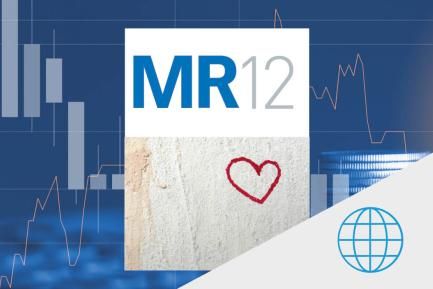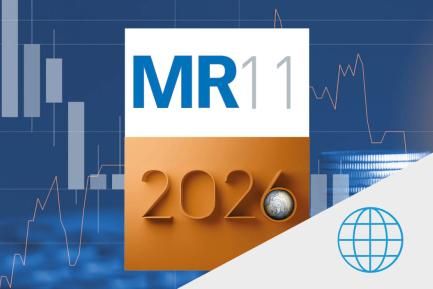
The global economy, at 95%
All the indicators suggest an incomplete recovery of the global economy in Q3
Pending the publication of GDP data for Q3 2020, the information currently available suggests that the global economy will have rebounded significantly compared to Q2, but that the recovery will still be far from complete. Whether it is data on mobility, industrial production, consumption or economic sentiment, when viewed together the various indicators suggest that the recovery is incomplete and, in recent weeks, the latest data suggest a certain stagnation. The global economy has remained at 95%. The scale of this unprecedented economic shock, the enormous uncertainty it entails and the persistence of the pandemic stand in the way of a complete and rapid recovery. The pandemic will thus remain the major determining factor for the economic scenario over the coming quarters and will continue to dictate economic activity until an effective vaccine and/or treatment is available. In this regard, our forecasts anticipate that global GDP will fall by around 4.5% in 2020, before recovering in 2021.

ADVANCED ECONOMIES
While there are differences between countries, on the whole advanced economies have followed a similar path in Q3: an initial recovery that has gradually lost strength during the quarter
In recent weeks, economic activity indicators such as the PMIs for August and September reflect a loss of buoyancy in the recovery (even stagnation) in the face of the rise in new coronavirus infections. In Europe, there is a resurgence of COVID-19 cases and the number of new daily infections has exceeded that of the US, which thus far has been one of the most concerning focal areas of the pandemic. This rise in cases has already led some countries to tighten measures to contain the virus. Although the situation is being managed with specific and more localised measures, uncertainty remains high and is weighing down the economy, despite the large number of measures taken by governments in advanced economies to help businesses and workers.

In the euro area, the collapse in economic activity in Q2 has given way to a partial recovery in Q3
The GDP declines registered in the main euro area countries in the second quarter of the year were unprecedented since the Second World War (in quarter-on-quarter terms, –11.8% for the euro area as a whole, –9.7% in Germany, –13.8% in France, –12.8% in Italy, and –17.8% in Spain). To the extent that these falls reflected the impact of the lockdown in spring, the lifting of the mobility restrictions has been accompanied by a marked rebound in European economic activity. Nevertheless, the underlying picture remains one of an incomplete and gradual revival. In fact, in the closing weeks of Q3, euro area economic activity indicators reflect a slowdown in the recovery. In particular, the strong rebound in retail sales following the lifting of the lockdown during the summer has lost strength in recent months (they fell by 1.3% month-on-month in July in the euro area as a whole) and in some countries they still remain below the level of February (for instance, Italy’s retail sales in July were around 13% below the February level). Unemployment continues to rise too (albeit very slowly, thanks to the widespread use short-time work compensation schemes) and the euro area’s unemployment rate reached 8.1% in August (+0.9 pps versus its pre-pandemic level). Finally, the severity of the economic scenario is also reflected in inflation figures that remain very weak: in September, headline inflation fell to –0.3% year-on-year, while core inflation shrunk to +0.2% (the lowest core inflation figure in euro area history).

Recalibration of the euro area macroeconomic forecasts
A smaller than expected drop in economic activity in Q2, together with the evident slowdown in the recovery at the end of Q3, has led us to recalibrate our macroeconomic forecasts for the euro area. In 2020, we now anticipate a fall in GDP of 8.2% in the euro area (versus a previous forecast of –10.4%). This revision is comparable by country: up to –5.8% in Germany (previously –7.3%), –11.5% in France (previously –12.9%), and up to –10.8% in Italy (previously –14.0%). Nevertheless, economic activity in the euro area is not expected to return to its pre-crisis level until 2023. In this regard, policies to boost the recovery and the transformation of the economy will be key (see the Focus «The effectiveness of fiscal policy in times of COVID» at www.caixabankresearch.com). Given how crucial EU support will be in this phase, the approval of the SURE programme is a very positive development. According to the agreement ratified in September, this European fund will disburse some 87 billion euros in the form of loans to European countries to help finance their national temporary workforce reduction programmes.


In the US, the recovery in economic activity in Q3 is showing more resilience, despite the persistence of the virus
The decline in GDP in Q2 (of 9.1% quarter-on-quarter) may be much greater than the contraction suffered during the Great Recession, but it is lower than that endured by other advanced economies, largely due to the country’s less stringent lockdown. However, the US remains one of the main focal areas of the pandemic, with over 40,000 new cases every day. Therefore, although the composite PMI remains comfortably above the 50-point threshold (54.4 in September), consumer confidence (which also continues to recover) remains low. Specifically, in September the consumer confidence index stood at 101.8 points, still below the level of February (132.6). Similarly, the New York Federal Reserve’s high-frequency economic index was practically stuck at –5% throughout September, and for Q3 as a whole it suggests that GDP will have been around –6% below its level in Q3 2019.

The high uncertainty surrounding the political environment in the US compounds economic uncertainty
In its latest forecasts for the US economy, the Fed highlighted the high degree of uncertainty surrounding the economic scenario. This uncertainty is well illustrated by the disparity between the Q3 growth figures predicted by the GDP forecast models of the Atlanta Fed and the New York Fed: 32.0% annualised quarter-on-quarter growth in the case of the former, compared to 14.1% in the latter. In addition, the uncertainty over how the pandemic will develop is compounded by the political uncertainty in the US, with the presidential and congressional elections just around the corner (on 3 November) and tough negotiations that lie ahead on a potential new fiscal package. Such a fiscal package would come in addition to the measures already approved to date, which amount to around 15% of GDP (9% in direct spending measures and 6% in guarantees and other liquidity-related measures).

EMERGING ECONOMIES
The recovery is proving highly uneven among emerging economies
As was evident in the GDP data for Q2, the initial impact of the COVID-19 crisis on emerging economies was highly varied and largely dependent on the macroeconomic imbalances that existed prior to the shock (inflation, budget deficit, private debt, etc.) and the degree of exposure to the most active outbreaks of the pandemic. Similarly, with the recovery underway, the intensity of the recovery also differs from country to country. In Turkey and Brazil, where the drop in GDP in Q2 was somewhat less dramatic (–9.9% and –11.4% year-on-year, respectively), the PMI suggests an improvement in economic activity in recent months. In Mexico, however, the PMI remains well below the 50-point threshold separating contractionary from expansionary territory, and it has shown little improvement in recent months. On the other hand, India’s economy, which suffered one of the biggest contractions among the world’s large countries (–23.9% year-on-year), is still showing signs of significant weakness.

China, meanwhile, continues to recover, although there are differences between sectors
China was the first country to suffer the economic shock of the COVID-19 outbreak, and it is also the country that has been in the economic recovery phase for the longest. In fact, industrial production has been growing again in year-on-year terms since April, at a time when most countries were tightening measures to contain the virus. On the other hand, retail sales, which in recent years were growing faster than industrial production, only returned to positive year-on-year growth in August (0.5%), an indication of how the pandemic and the uncertainties it entails continue to weigh down consumption.



